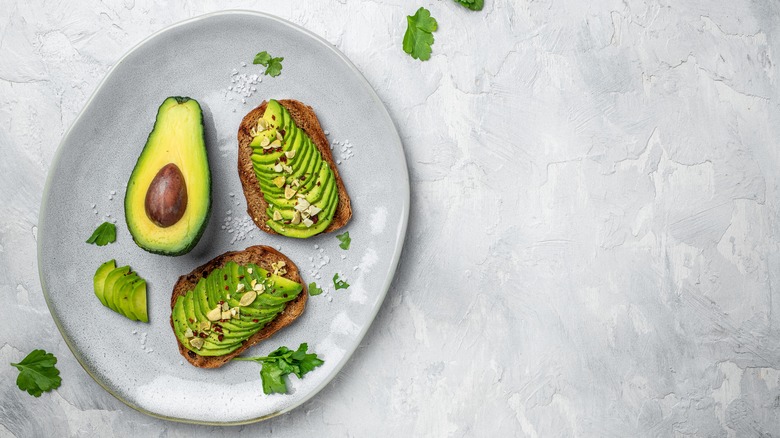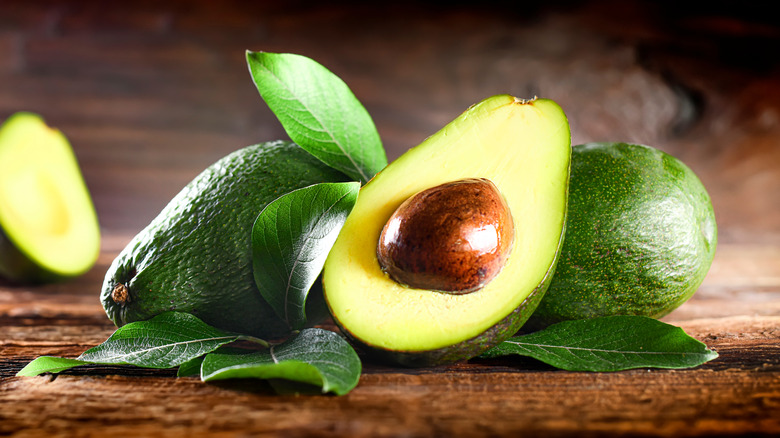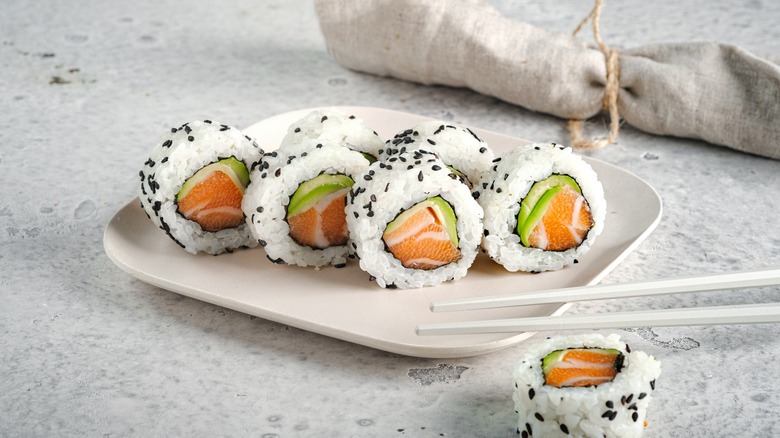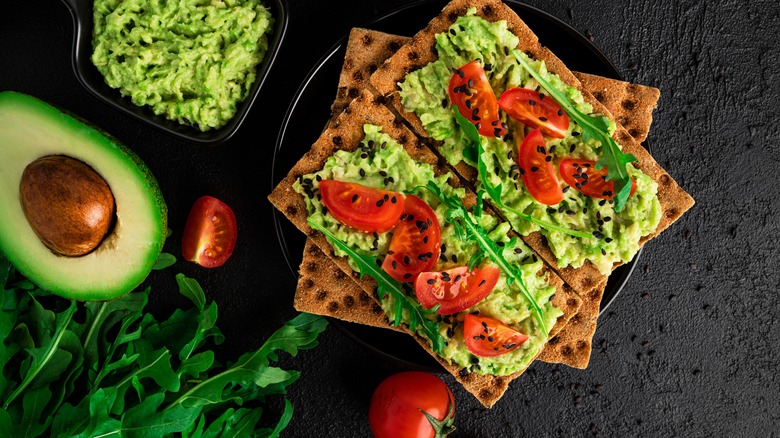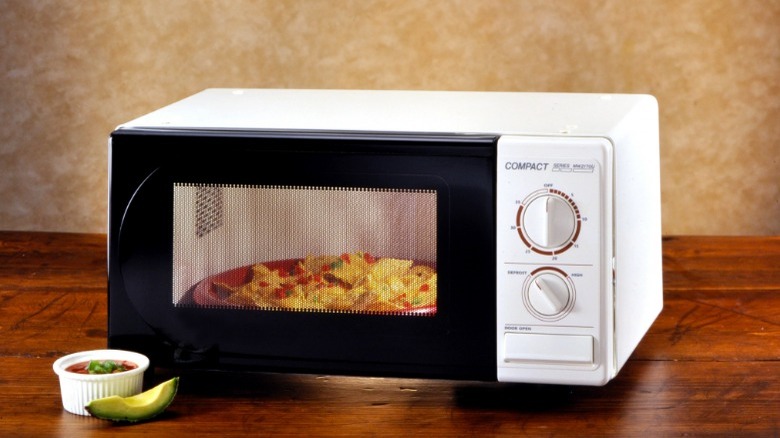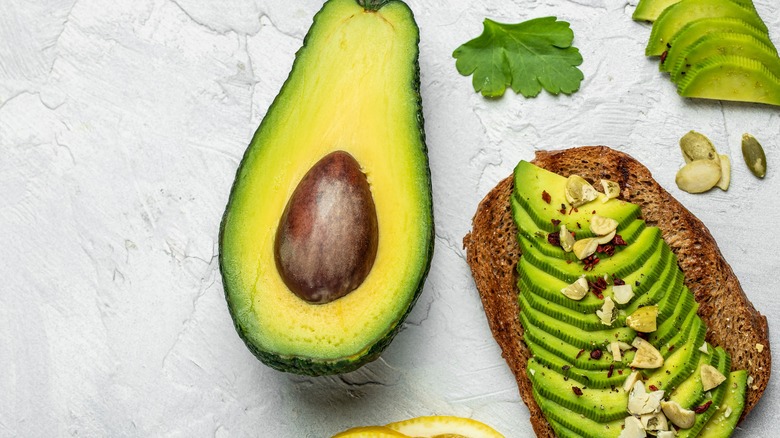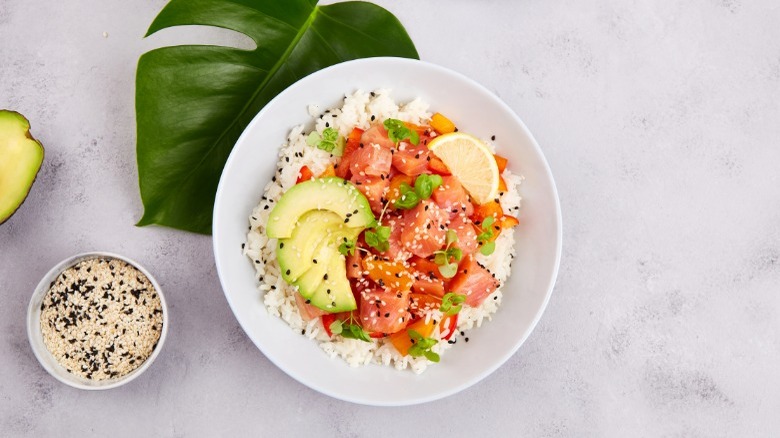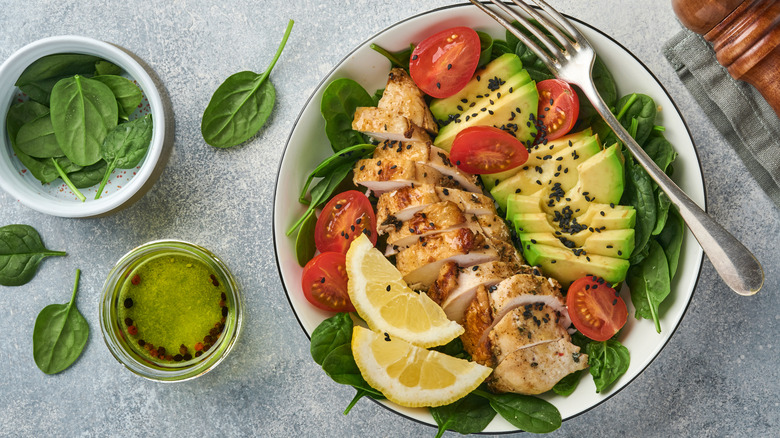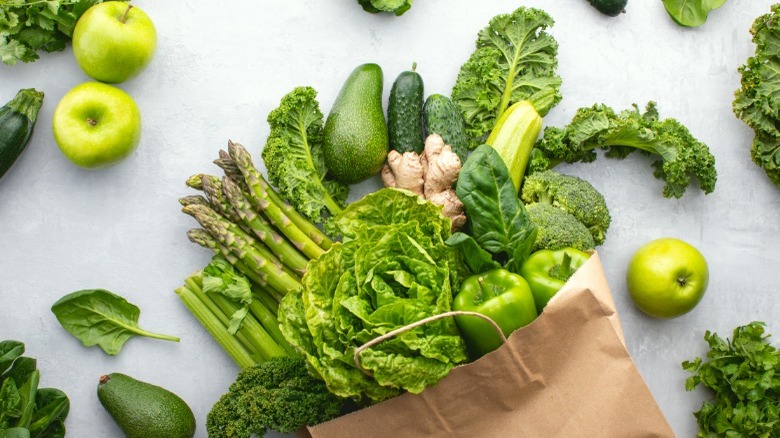6 Tricks To Make Your Rock-Hard Avocados Ripen Faster
Avocados are an incredibly versatile ingredient. The fruit can be used as the shining star in a classic fresh guacamole, hearty avocado toast, or even creamy vegan pesto sauce, among a myriad of other delicious recipes. However, like any other fresh fruit or vegetable, avocados have a window of time where they're considered to be most ripe, characterized by a slightly bouncy feel, a green or yellow color to the small indentation at the top of the fruit, plus a very dark green to black hue (via Yummy Mummy Kitchen). When they're ready to go, cutting into the flesh will be a breeze, resulting in a creamy interior ready to be used in tacos, sandwiches, and more.
But what if you've bought some avocados from the store, it's been three to four days, and you're still waiting for them to feel just right? While it's best to wait for the fiber-rich fruits to naturally ripen, there are a few tricks and tips you can try to quicken the process. Read on to discover our favorites.
How long do avocados take to ripen?
Generally, it usually takes an avocado around three to four days to completely ripen after bringing it home from the grocery store or farmer's market. According to Avocados From Mexico, you'll know it's ripe when the external texture is slightly bumpy and generates gentle pressure when you squeeze it. Overly ripe avocados will feel mushy, while ones yet to mature will feel overly firm.
If you accidentally cut into an unripe avocado (don't worry, it's happened to the best of us), you can rub the interior flesh with lemon or lime, put it back together, wrap it tightly with plastic wrap, and store it in the fridge. That being said, if you're just waiting for your avocado to ripen the old fashioned way, you can place it on your countertop. You can choose to place it in a paper bag by itself or with a fruit (we'll get to that later), or even opt for a warmer, sunnier spot in your kitchen.
Is it okay to eat an unripe avocado?
Although it's likely not the most pleasurable experience, it's 100% safe to eat an unripe avocado: Nothing weird will happen to your stomach, but you'll probably be left feeling slightly unsatisfied. As stated by Plant Food At Home, an unripe avocado won't have as much flavor and won't be as creamy as a ripe one. This means that the unripe fruits aren't the best to use in avocado-heavy recipes, like guacamole, sushi, or even tacos.
That being said, avocados as a whole are a very healthy fruit. They contain healthy fats, fiber, folate, potassium, magnesium, carotenoids, and vitamins B, C, E, and K, as stated by the Harvard School of Public Health. What's more, eating half an avocado a week has been found to potentially lower the risk of cardiovascular disease and type 2 diabetes. Additionally, regular consumption has been found to help with eye health and helping to improve your gut microbiome.
1. Stick the avocado in the oven for a bit
If you're familiar with making baked potatoes in the oven, this trick will already sound pretty familiar. To soften the fleshy part of an avocado, you can preheat your oven to 200 degrees Fahrenheit, wrap it in tin foil, and throw it in, making sure to check on it every 10 minutes. It's important to note that this won't necessarily speed up the ripening process, but it'll make the texture much softer and creamier, allowing you to use it in recipes that rely on its feel rather than its taste.
Sandwiches or burgers, for one, would do great with this hack: After taking your newly softened avocado out, you can scoop some of it out and smear it onto your favorite bread, like sourdough or honey oat. Check out this recipe for smoky, Tex-Mex inspired avocado and hatch green chile cheeseburgers on brioche. You could even try grilling half an avocado and stuffing it with tomato and feta.
2. Cut it in half and pop it in the microwave
If your avocado is still a day or two out from being completely ripe, the oven may be too harsh. Enter: the microwave, which is another handy gadget that can help advance the softening process. To do this trick, you'll want to cut your avocado lengthwise and wrap each half in plastic wrap. From there, you can heat it up in 30 second intervals, checking on the interior each time (via Country Living). Like the oven hack, this won't ripen the avocado, but rather soften it for use, making it another good option for recipes that rely on its creaminess. Be warned that it still might not have developed the delicious, creamy taste you might be after.
After that, make sure to stick the halves in a bowl of ice water to stop the cooking process. This ensures that your avocado won't turn into a mushy mess and that it will maintain its texture. If you'd like to use your avocado in a slightly different way, try turning it into a super refreshing cucumber and avocado gazpacho with grapes.
3. Place it on a counter in the sun
This tip won't warrant immediate results, but it's a sure-fire way to push your avocados to ripening just a tad bit faster. Start by placing your avocado in a bowl in a spot where your kitchen — or another room in your house if you don't mind having avocados as some new interior decoration — gets some direct sunlight. From there, all you have to do is let the sun do its magic. Your avocado may ripen within a day or two of putting them out, but time is of the essence for this trick (via Avocados From Mexico).
However, as a heads up, you'll want to ensure that your avocado isn't getting too much sun. Direct warmth and light can very quickly be more harmful than helpful, ultimately pushing it even closer to rotting altogether or getting mushy spots. If you decide to do this, make sure you're keeping a close eye on your avocado once it's in the sun.
4. Put it in a bowl of rice
We can't completely vouch for the effectiveness of this hack, but it's still worth a try if you're in a pinch and want to test something out. It's simple: Put your avocado in a container of uncooked rice, and make sure that the fruit is completely covered (via Women's Health). The idea here is that the rice will trap ethylene gas, which is naturally emitted by fruits. When this gas is produced, fruits will begin to ripen. According to Garden Know How, ethylene gas is actually a plant hormone that encourages its development and growth.
This rice hack is also designed to block out any moisture, which should prevent the avocado from developing mushy spots. You may notice a change after one or two days of being submerged. Hopefully when this trick works for you, you can use both the avocado and rice to make a grilled chicken, avocado, rice and cheddar burrito, or a black bean, avocado, brown rice, and chicken wrap.
5. Store it in a paper bag or newspaper on its own
Perhaps one of the more well-known ripening tips, this is one trick that will most definitely result in a ready-to-use avocado. Should you have a day or two to spare, pop your avocado in a brown paper bag or wrap it in newspaper (via The Pioneer Woman). Similar to the uncooked rice tip, the paper material will help trap ethylene gas, which will work to speed up the ripening process. After some time spent in the bag, you'll notice that your avocado will likely have changed a bit in texture, feel, and color, moving more towards what a ripe avocado looks and feels like.
As explained by SFGATE, paper bags are ideal because air is still able to reach the avocado, which helps it to ripen more evenly. If you were to use a plastic bag, for example, the air can't circulate, so the process won't work as effectively.
6. Place the avocado in a paper bag with another fruit
If you're looking to ripen avocados faster, one tried-and-true trick is to place them in a bag with another piece of fruit, such as an apple, banana, or kiwi (via Kitchn). This tip works as you're surrounding the fruit with something else that's also emitting ethylene gas, ultimately working to accelerate the ripening process.
As stated by Garden Know How, apples and pears produce a greater amount of ethylene, while cherries and blueberries emit very little. It's therefore important to consider the fruit you choose, rather than just sticking any old thing in there. With an additional fruit in the bag, other gasses are also exchanged, like carbon dioxide and oxygen. All together, this pushes the avocado towards changes in its texture, color, and feel. Within one or two days, you'll be greeted with a perfectly ripe avocado that's perfect for dips, pastas, and burgers galore. Of course, this isn't the quickest technique on the list, but it's arguably the most effective.
